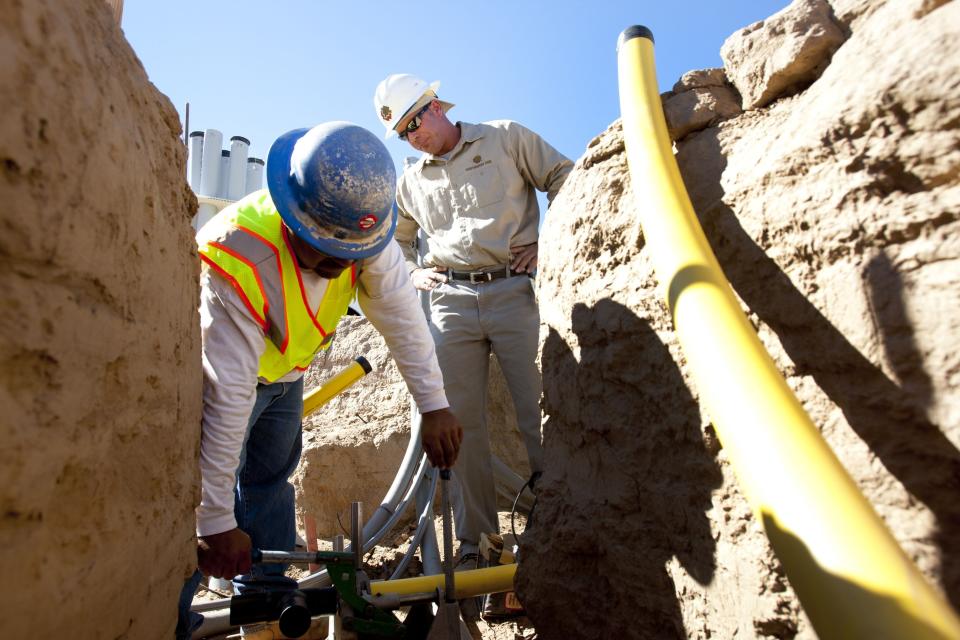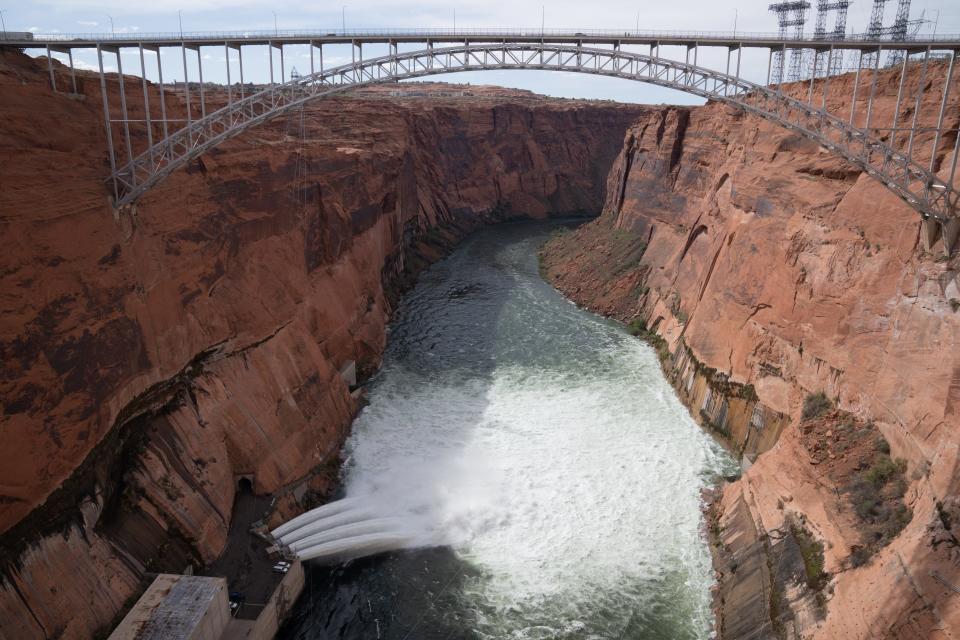The race to produce hydrogen fuels in Arizona is on. It's promising, but not yet funded
Corrections & Clarifications: An earlier version of the article incorrectly described the connection between production and export in hydrogen fuel programs. These efforts are production that will occur generally in Arizona and are not necessarily related to the SHINe proposal.
The race to decarbonize energy is on, and Arizona is in the running for approximately $1 billion in federal funding to make it happen.
Last month, about 40 member organizations collectively known as the Southwest clean Hydrogen Innovation Network, or SHINe, submitted a second round of proposals to the U.S. Department of Energy outlining their plans to make the Arizona and Nevada collective a producer of hydrogen-based energy.
They were one of 33 groups, out of an original 79, to advance to this next round in the race for funding from the Biden Administration's $8 billion clean hydrogen initiative through the Bipartisan Infrastructure Law. The program, announced last June, will ultimately fund between 6 and 10 winning projects designed to help "jump-start America's clean hydrogen economy."
Now, they wait.

Reviewer questions are due May 31 and will be followed by pre-selection interviews, said Joe Varela, Director of Emerging Technology and Innovation at Southwest Gas, one of the utilities participating in Arizona's bid for hydrogen funding.
"And then, fingers crossed, fall of 2023 we’ll hear the good news," he said.
In the meantime, there are still plenty of pieces to get into place before Arizona has market-ready hydrogen fuels.
Among those are transportation issues, since hydrogen is 14 times lighter than air, less energy-dense than natural gas and can react corrosively with the steel many energy pipelines are made from. There are also concerns about hydrogen gas, a very small molecule, escaping from containment and causing explosions or combining with other molecules in the air to create more ozone and greenhouse gases, which are causing average global temperatures to rise.
And then, in the desert, there's the issue of water, since the electrolysis methods of creating carbon-free hydrogen require water as an ingredient and there is less and less of that to go around in Arizona.

What is "green" hydrogen?
Despite — or maybe because of — all these unknowns, the hydrogen scene is busy. Last week the financial advising company Deloitte, together with the World Wildlife Fund, an environmental nonprofit, published an assessment of green hydrogen for industrial heat. The industrial practice of generating high levels of heat for manufacturing processes through the burning of fossil fuels is a large source of greenhouse gas emissions that has proved one of the most difficult to decarbonize. Deloitte and WWF argue that the development of green hydrogen as an industrial fuel source will be essential to meeting climate goals and limiting the effects of global warming.
Hydrogen, or H2, consists of two hydrogen atoms bonded together. It is highly flammable at certain concentrations and thus useful as a fuel. It is being developed as a low-carbon fuel source because, unlike methane, which is made up of four hydrogen atoms bonded to a carbon atom, or coal, which is a lot of carbon bonded to atoms of elements including hydrogen, oxygen, nitrogen and sulfur, breaking the bonds of H2 to release energy doesn't necessarily involve carbon.
In contrast, breaking carbon bonds by burning diesel, for example, which is a molecule made up of many hydrogen atoms bonded to carbon atoms, causes the atmospheric formation of heat-trapping greenhouse gases like carbon dioxide that are driving climate change.
More: Grass for gas? Researchers, businesses weigh options for sustainable aviation fuel
Green hydrogen is considered "green" not because of its color (H2 is colorless), but because it is produced when energy from renewable sources like solar or wind is used to break the chemical bonds of water — two hydrogens bonded to an oxygen — to produce O2 and H2, which is then captured and stored as a fuel.
Similarly, "pink" hydrogen is produced when nuclear energy is used to create H2 from water molecules. It is considered carbon-neutral because, like green hydrogen, the process doesn't directly result in the release of more carbon into the air.
But hydrogen fuels, the Deloitte report explains, can also be produced using natural gas, pure methane, or even coal to generate "blue," "turquoise," "grey," "brown" or "black" hydrogen, depending on the energy input source and whether the carbon byproduct is captured rather than emitted into the atmosphere.

Leveraging Arizona's natural energy sources to turn water into fuel
Arizona efforts, Varela said, will likely pursue a mixture of methods for producing hydrogen fuels, including some that use natural gas as an input feedstock but make an effort to capture the carbon byproducts. As long as the end result is a reduction of carbon emissions per unit of energy produced, compared to just burning fossil fuels, he thinks the reliability and financial viability of hydrogen fuel hubs will be improved, at least initially, by blending strategies rather than trying to cut straight to using only renewable energy inputs.
"If you go too far in one direction, whether it be hydrogen from solar or wind and you leave out the potential for making hydrogen from renewable methane or biogas sources, then you kind of put yourself in a situation where you don’t have this nice diverse portfolio where hydrogen produced meets the standards of the program," Varela said.
In the long run, Arizona's solar potential and availability of nuclear energy from the Palo Verde plant 50 miles west of Phoenix make the state a promising location for the production of "green" hydrogen using renewable energy inputs or "pink" hydrogen using clean energy to break the bonds of water. And in addition to improving their chances of winning funding from the infrastructure law, meeting federal standards for reducing the amount of carbon dioxide emitted per unit of hydrogen fuel produced will also bolster project economics by qualifying SHINe partners for tax benefits as part of the Inflation Reduction Act, Varela said.
More: Without an energy office, will Arizona get its full share of the Inflation Reduction Act?
These IRA hydrogen tax credits are so appealing, in fact, that some experts have worried, as reported this week by Heatmap News, that diverting nuclear energy toward the development of hydrogen fuels nationwide could result in short term emissions increases if more fossil fuels are burned to make up for nuclear energy missing from the grid before hydrogen is fully online as an alternative fuel.
In Arizona, the use of nuclear energy in hydrogen fuels production could address concerns at Palo Verde reported by The Republic in 2019 that solar development might eventually replace the need for the nuclear plant. Palo Verde started working with the Idaho National Laboratory that year to test the process of using nuclear energy not needed during cooler parts of the year when energy demand is lower to produce hydrogen fuels that could then be blended with natural gas, stored and used as an energy source at times when solar power is not available.
“The thing I think is exciting for Arizona is that, right now, we’re a big energy importing state," said Ellen Stechel, executive director of the Arizona Center for Carbon Neutral Economy at Arizona State University and one of the leaders on the SHINe initiative. "But Arizona can turn around and become an energy exporting state and satisfy needs around us. (Hydrogen) opens up a lot of economic opportunity for the state to serve other areas which don’t have an abundance of sun.”
"We do have to worry about how much water we use," she added. "So we have to monitor that."

Navigating tradeoffs
Is it wise to pursue fuel generation that requires water in Arizona given the conflicts and uncertainty surrounding the Colorado River and recent drought? Stechel said she thinks it is, "cautiously."
"You’d be surprised how much hydrogen you can make from a little bit of water," she said. "If you think about it in terms of how many toilet flushes, it’s a very small amount that would make an awful lot of hydrogen, which we’re not going to scale up to very fast. That being said, water is something we want to pay very close attention to."
Varela likened the amount of water SHINe aims to ultimately put toward hydrogen fuel production as about the same currently used by golf courses in Arizona. But he said they are planning another study to get a better estimate. Stechel is also working closely with the new ASU Water Innovation Initiative, launched just last week with a $45 million budget, to be mindful of local water use as hydrogen fuel development progresses.
The other main obstacle that Southwest Gas, a pipeline and distribution company operating in Arizona, Nevada and part of California, is working on is how to distribute hydrogen through infrastructure that is currently composed of metals sometimes made brittle through contact with hydrogen gas, a chemical process known as "embrittlement."
Just last week, a report released by the National Transportation Safety Board determined that a pipeline explosion in 2021 that killed a man and his daughter in Coolidge was caused by corrosion related to the pipes having been originally designed to carry crude oil and not properly maintained after being repurposed for natural gas.
More: An Arizona pipeline explosion caused death and destruction. Here's what sparked it
“What we’re currently in the process of doing is research and development on how we can inject hydrogen into our existing infrastructure in order to displace that wellhead natural gas with hydrogen on an energy-equivalent basis," Varela said. "So we’re testing how (blends of natural gas with) hydrogen from 5% to 20% impact safety and performance."
Others have expressed concerns about harmful ways escaped hydrogen can react with other molecules in the atmosphere.
In an April 27 panel presentation by the Hamilton Project and the Stanford Doerr School of Sustainability, Dean and mechanical engineer Arun Majumdar said he's a big fan of hydrogen as a clean energy source, but that we have to be aware of the tradeoffs.
"There is a shot on hydrogen," Majumdar said. "But you have to realize that hydrogen leaks much more than methane. And when it goes in the atmosphere, it takes away some of the reactions (with UV light) that are used to remove methane naturally. And as methane concentrations go up, we're in big trouble. So, should we not go into hydrogen? No, we should. But we have to figure out ways to understand and actually protect that happening."
Read our climate series: The latest from Joan Meiners at azcentral, a column on climate change that publishes weekly
Overall, despite the obstacles that remain, research and funding investments suggest that hydrogen will play a role in decarbonizing the energy sector to help mitigate climate change. Maybe, if the SHINe proposal is successful, especially in Arizona.
"This industry is going to happen no matter what in Arizona," Stechel said. "It’ll happen faster, I think, if we win this. But it’ll happen. Hydrogen is coming to Arizona. We want to help make it bring the most benefits to Arizonans."
Joan Meiners is the climate news and storytelling reporter at The Arizona Republic and azcentral.com. Before becoming a journalist, she completed a doctorate in ecology. Follow Joan on Twitter at @beecycles or email her at joan.meiners@arizonarepublic.com. Read more of her coverage at environment.azcentral.com.
Support climate coverage and local journalism by subscribing to azcentral.com at this link.
This article originally appeared on Arizona Republic: Hydrogen fuels are promising, but Arizona still needs the funding

